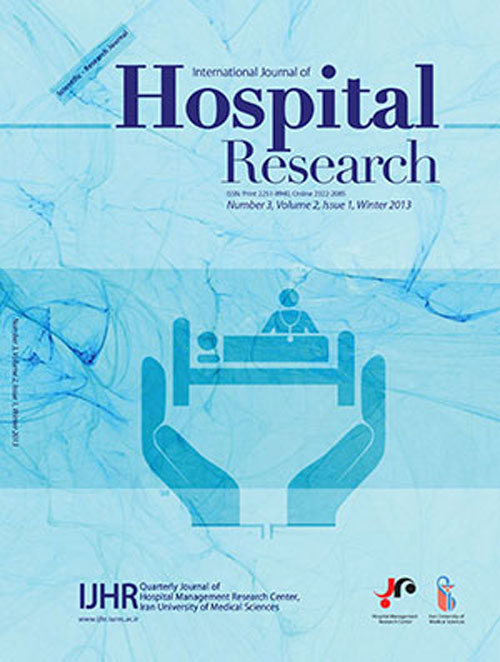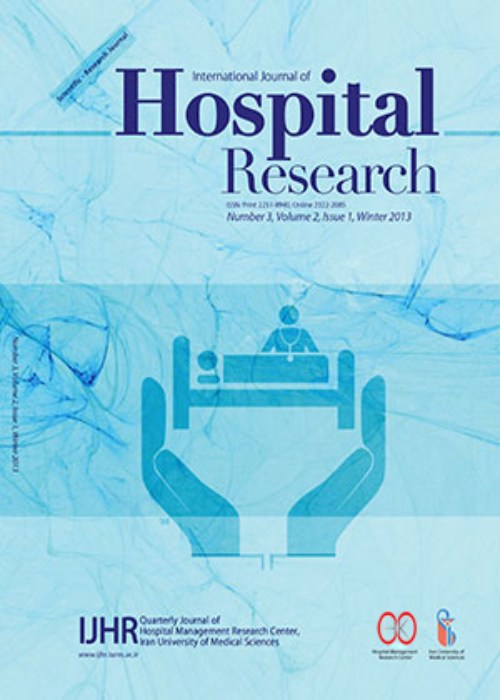فهرست مطالب

International Journal of Hospital Research
Volume:4 Issue: 1, Winter 2015
- تاریخ انتشار: 1394/01/17
- تعداد عناوین: 8
-
-
Page 1Background And ObjectivesIn this paper, a real life nurse scheduling model is described based on the conditions in Iranian hospitals such as monthly shift rotation, consecutive morning and evening shifts and consecutive evening and night shift.MethodsThe developed model considers both hospital constraints and nurses’ preferences. Hospital constraints include assigning adequate qualified number of nurses to all working shifts and avoiding inappropriate sequence of nursing shifts. Nurses’ preferences include the nurses’ monthly requests and observing the fairness in ratio of work hours, off weekends, night shifts and undesirable shifts. A hybrid of lexicograph and weighted sum method was used to solve the multi objective problem. The objectives were normalized and the importance of the objectives was determined by the Analytical Hierarchy Process method. In this work, new conditions are considered based on customized considerations. The model was evaluated by comparing the computationally determined schedules with manually determined schedules.FindingsComparison of the manually and computationally determined schedules shows the superiority of computer-based method over the traditionally manual method based on the scales of the hospital.ConclusionsThe study provides further support for the utility of sophisticated computational method in improving hospital processes, which can ultimately translate into enhanced patient care and hospital performance.Keywords: Nurse scheduling, Nurse preference, Shift rotation, Hospital management
-
Page 9Background And ObjectivesMonitoring of nursing performance on a regular basis is crucial for continuous improvement of nursing services management. The aim of this study was to propose an assessment model for the monitoring and evaluating the performance of the nursing services by nursing services managers.MethodsA Delphi-based qualitative research method was adopted. Based on the literature data, 120 questions were formulated. Three Delphi rounds were held and eight experts were referred to for their opinions in each Delphi round. The data derived from experts’ opinions was analyzed using of the content validity index.FindingsThe assessment form comprises of 63 indicators related to patient care, nursing services, and nurse qualification. The visit form allows inquiring not only on the quality of services, but the process of services delivery, as well.ConclusionsThe evaluation model developed in this study can facilitate continuous monitoring and assessment of nursing services performance.
-
Page 15Background And ObjectivesEffective communication between managers and staff is a prerequisite to organization success. Cultural competence is key to effective communication. The aim of this study was to survey cultural competence in managers of selected hospitals.MethodsTwenty teaching hospital managers and four private hospital managers of senior level participated in the study. Data were collected via research-made questionnaire which was examined in terms of validity and reliability. The questionnaire consisted of 30 questions related to three dimensions of cultural competence, including cultural awareness, cultural knowledge, and cultural skills. Data were summarized using descriptive statistical methods. T-test was used for comparison of the mean values.FindingsThe average score of cultural awareness, cultural knowledge and cultural skills was found to be 42.41, 45, 44.12, respectively giving a total cultural competence score of 43.84. No significant difference in cultural competence and its dimensions was observed between managers of teaching and private hospitals.ConclusionsAccording to our study, the surveyed hospital managers enjoy a relatively high cultural competence, though there is still room for further improvement particularly in terms of cultural skills. The relatively small sample of this study, however, warrants caution in generalization of the results and call for further large-scale studies to explore this important factor among hospital managers.Keywords: Cultural competence, Hospital manager, Communication, Hospital performance
-
Page 21Background And ObjectivesThe healthcare organization are often fail to realize their strategic goals due to the lack of effective leadership. To address this efficiency, factors can possibly influence the management performance should be identified. Thus, the purpose of this study was to evaluate hospital managers’ leadership style and explore the relationship between leadership style in hospital executive managers and their leadership readiness and leadership effectiveness.MethodsThe study sample included the entire (96) C-level healthcare executives currently employed in the Iran University of Medical Sciences, including chief executive officer (CEO), chief financial officer (CFO), chief human resource officer (CHRO), chief information officer (CIO), chief nursing officer (CNO), and chief operating officer (COO). The study instrument was a questionnaire asking about respondents’ leadership style questions, leadership effectiveness and leadership readiness. The collected data were analyzed using Pearson’s correlation coefficient and single variable and multivariate regression.FindingsTransformational leadership was found to be the dominant leadership style among the executive managers. The leadership readiness was found to be significantly correlated with transformational leadership (P < 0.05). Moreover, leadership effectiveness showed significant correlation with transformational/transactional leadership style (P < 0.05).ConclusionsOur study suggests that adopting active management which represents both transformational and transactional managing style can lead to an improved leadership effectiveness in healthcare organizations.Keywords: Hospital management, Healthcare organization, Leadership style, Leadership effectiveness, Leadership reediness, Transformational leadership, Transactional leadership
-
Page 27Background And ObjectivesThe Iranian Ministry of Health and Medical Education (MOHME) has obligated health settings to follow the reference guidelines developed by the Ministry in implementing of emergency department triage system. The present study aimed at auditing the compliance of emergency department triage system in Shahid Madani hospital, in terms of compliance with MOHME guideline, and to explore the impact of relevant interventions in enhancing this compliance.MethodsA check list developed based on the Ministry’s guideline was used as the study instrument. Two areas including inputs and processes were surveyed. After auditing the initial state of the triage system, interventional strategies such as keeping the triage active in the afternoon and night shifts, allocation of welcoming patient carrier, and training the staff on the standards of triage system was implemented and the triage system was re-audited. Descriptive statistics and graphs were used to describe the results. T-test was used to compare the degree of compliance before and after intervention.FindingsBefore introducing the intervention, a compliance degree of 80, 62, and 88%, the standards of physical space, staffing, facilities and equipment and 80%, 14% and 67% to service process, logistic process, and management process was identified, respectively. After implementation of intervention, the degree of compliance was found to be 80, 87, 92% for the three former areas, and 90%, 14% and 100% for the three latter areas, respectively. The overall degree of compliance showed a significant increase from 75% to 82% after intervention (P = 0.028).ConclusionsThe adherence of emergency department triage system to the reference standards can be improved by implementing relevant interventional strategies. The gap between degree of compliance after intervention and the ideal situation, however, shows the need for more comprehensive identification of the shortcoming and devising appropriate strategies.Keywords: Clinical audit, Triage, Emergency Department, Hospital management
-
Page 33Background And ObjectivesThere are different types of vascular access. We compared the patency rate for six months in ulnar-basilic fistula and Radio-Cephalic fistula for vascular access in hemodialysis patients.MethodsThe study was performed on 60 patients of 50.6±13.5 years of age with end-stage renal failure undergoing hemodialysis from 2012-2014 in Imam Ali hospital in Zahedan. Patients were divided into two groups. The first group was established anastomosis of wrist radial artery and the cephalic vein and in second group between ulnar artery and vein Basilic in the forearm. Both groups were followed up with respect to patency of the fistula for six-month.FindingsThe mean duration of renal failure requiring transplantation among patients was 1.4±1.0 year. The frequency of patency after six months in ulnar-basilic fistulas was less than that in Radio-Cephalic group, however, the difference was not significant (76% vs. 70%, P > 0.05). All fistulas in two groups showed thrill, except one patient (3.3%) in ulnar-basilic group (primary failure). Hypertension was detected in one patient in Radio-Cephalic group, moreover, hematoma was observed in two patients in ulnar-basilic and in two patients in Radio-Cephalic groups and thrombosis was observed in two patients in ulnar-basilic and in a single patient in Radio-Cephalic groups. The aneurism was observed in three patients (10%) in ulnar-basilic and in four patients in Radio-Cephalic fistulas. The steal syndrome was observed in two patients in Radio-Cephalic group, infection in one patient (3.3%) in ulnar-basilic fistulas group and in four patients (13.3%) in Radio-Cephalic group.ConclusionsFistula patency rates were comparable in both ulnar-basilic and Radio-Cephalic groups and there is no significant evidence of postoperative complication difference between two groups.Keywords: Hemodialysis, ulnar, basilic fistula, Radio, Cephalic fistula, ESRD
-
Page 37Background And ObjectivesAccreditation is a widely used mechanism to keep organization adherent to the established standards. The aim of the study was to identify barriers towards promotion of accreditation in the Iranian hospitals, and exploring the potential overcoming strategies.MethodsA qualitative study design was adopted. Data were collected using a questionnaire with open questions about barriers to and potential solutions of accreditation implementation in Iranian hospitals (N= 116). Thematic analysis was used to extract the major concepts.FindingsLimited knowledge of the personnel, inadequate training of the staff and lack of commitment of managers and physicians were identified as the most important challenges towards successful implementation of accreditation. Respondents enumerated extensive training, involvement of chief managers, and adapting the hospital’s organizational culture as the potential drivers of accreditation in the Iranian hospitals.ConclusionsThe three categories of barriers to accreditation as well as the suggested overcoming strategies are interconnected, all of which pointing towards the need for extensive training for developing the required infrastructure, at least in terms of human resources, for promotion of accreditation in the Iranian hospitals.Keywords: Accreditation, Hospital, Training, Hospital management, Organizational culture
-
Page 43Background And ObjectivesHand hygiene (HH) is crucial for preventing of infectious complications in health care settings. Informing healthcare workers on the recommended hand washing method can promote this practice in the clinical staff. This study aimed to evaluate the impact of training the WHO-recommended five-moment hand washing method in promoting hand hygiene in a health care setting.MethodsNinety-eight clinical staff of Erfan Hospital participated in a training course. After training, the frequency of hand washing by the participants was compared with that before training. Chi-square test was used for examining the significance of the difference.FindingsA significantly increased frequency of hand-washing was observed in the clinical staff after the training course (P < 0.05).ConclusionsThis study emphasizes the importance and effectiveness of training in controlling factors contributing to provenance of nosocomial infections.Keywords: Hand hygiene, Hand washing, Nosocomial infections


